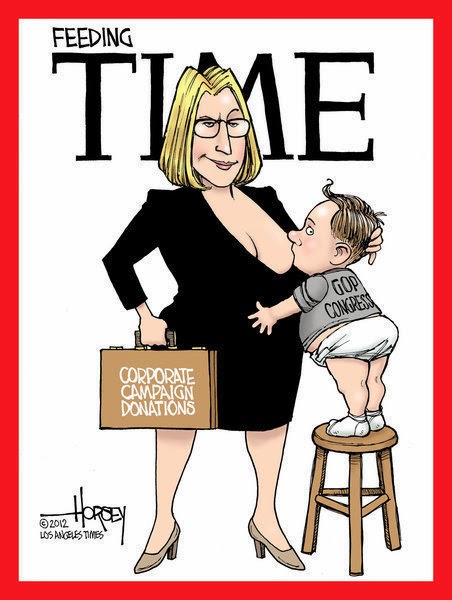Liberals are considered pro-union and Conservatives are considered
pro-business. This belief has some historical significance but it is hard to
prove by modern times, where unions, comprising 7% of the work force have little
clout, and big business is running the country through the power of the mullah.
But politicians love to talk about helping the small businesses of
our country. Republicans really love that rhetoric. If you have to pay labor
too much the businesses will fail and there will be more unemployment. So, give
businesses tax breaks, incentives, and outright gifts and the money will
trickle down the folk who work for them. Horse Puckey, we have over thirty
years that shows that doesn’t work.
As in Voodoo economics it is the method of magician’s misdirection.
We also have strange ways of talking about “small business.” The Small Business
Association (SBA) defines a small business as one that in independently owned
and operated, organized for profit and is not dominant in its field. In
manufacturing those employing 500 to 1500 are small businesses. In wholesaling
it is 100 to 500 employees. In service receipts are between $2.5 to 21.5
million. Retail $5 to $21 billion. Agriculture receipts under $.5 to 9 million.
All of these are depending on unnamed factors.
Small Business?
What? Hundreds of employees and millions of dollars is small
business. Call me behind the times, but when I think of small business I think
of Mom and Pop stores with a couple of employees who only dream of a million
dollars. I think the founding fathers would say, “Huh?”
What I think the SBA defines as a small business is a big business.
But it may seem small compared to today’s mega-businesses. Walmart has 1.4
million workers (in this country) the world’s largest private employer and had
sales of $258 billion in 2009. IBM has 426,751 employees, UPS 400,600,
McDonalds 400,000, Target 355,500, Kroger 338,000, HP 324,600, Sears 312,000,
PepsiCo 294,000, Bank of America 288,122, GE 287,000, and Northrop Grumman at
the bottom of the top 50 with a mere 117,000 employees.
Now let’s turn back to the dangers for small businesses, real and
conjured by the SBA. What is the biggest
threat to small businesses? I think that is quite simple – Big Businesses. All you have to do is look at the 19th
Century when big businesses entered the scene and took over corporate American.
Standard Oil is the simplest and best example. Standard Oil would put a filling
station in town and drop its prices below cost until it ran all its competition
out of business. Then it was free to set whatever price it wanted for gasoline.
It still happens today. Cabella, a sporting good store will not
condescend to come to a town unless that town promises lower taxes for it
(TIFs). In one town the town did just that and drove out of business that was
good sized, provided the same products as Cabela but was drive out of business
though this unfair tax policy. Example: Cabella in 2005 persuded Fort Worth
politicians that bring their chain with an annual sales of 1.7 billion into
Fort Worth would need $30 to $40 million in tax breaks telling them it would
bring in 2.5 million visitors a year. Check out lots of examples on the Internet.
Now everyone likes to get good cheap prices, but they can come at a
very high cost, especially to small businesses. One study showed that when
Walmart open a store in the Austin neighborhood of Chicago’s West side there
were 306 businesses in the area. Two years later 82 of them had closed. Those
closest to the store were the most likely to close. FOX news anchor Dagen
McDowell demonstrating their usual sensitivity said, “Ma and Pa need to get
over it.” Ben Stein threw his weight behind it saying Walmart is an incredibly
great American institution.
In schools we are making an effort to stop bullying. That is a good
think. In business, bullying seems a business model.
Now I don’t believe big is always bad. COSTCO is a good example of
a large company who pays it workers well and benefits the communities it sells
in. But there still is a cost to small businesses.
No matter how you cut it, in small businesses like the Mom and Pop
stores there was trust. There had to been or the business wouldn’t stay in
business. Folk would just take the business to another small business who
treated them better. Now we have less and less options. And big businesses
spend millions to finagle our trust.
It is a pretty common experience to walk into a large store such as
Best Buy and find it nearly impossible to find someone to wait on you while you
see clusters of employees gathered together socializing. Then they do you a big
favor of waiting on you and it is a crapshoot as to whether they know their
product or not; but they are well trained to sell. In one of those stores when
I had brought back a third computer the didn’t work properly because they had
not installed software properly, and was a bit miffed, a big dude came over and
said, “I understand you old people can get pretty upset about stuff…” And this
guy didn’t even work in the area but was in security. I guess he figuring this
old man standing 5 foot and 3 inches and weighing 150 pounds dripping wet in a
overcoat would be a major threat to teenager who wasn’t listening to him.
It’s simple, the biggest threat to small business is big business.
But big business has enough political clout to get tax breaks, and control
government to write laws that benefit the overpaid CEO’s.
Big is not always beautiful. And big business has a lot of bullies.





"And big business has a lot of bullies."
ReplyDeleteThat has been documented and confirmed .